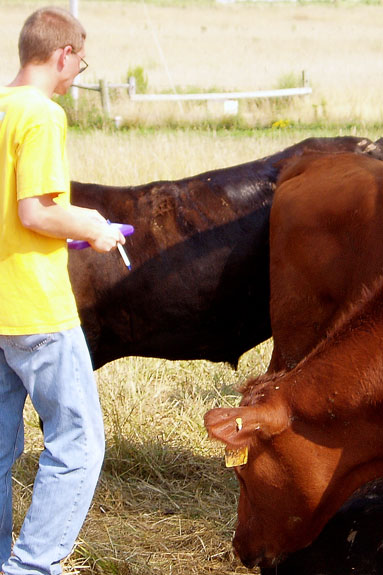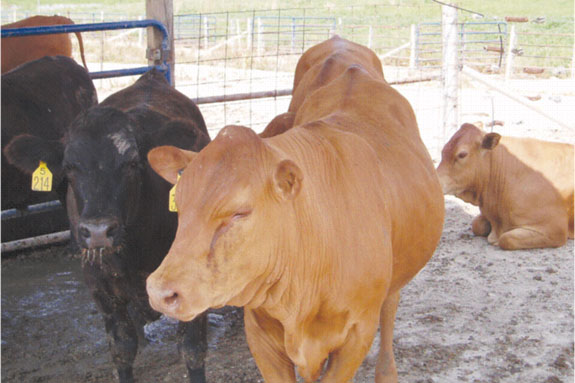The annual impact on the dairy industry is about $897 million per year and estimated at $369 million per year in beef production.

Dr. Don Spiers, from the Division of Animal Science at University of Missouri, has studied heat stress for many years.
His current work involves development of a smartphone application (app) for producers to identify heat stress at their specific location and its impact on their livestock.
“We’re also developing a website for heat stress. Our group received a small grant from the University of Missouri to work with students in computer science and journalism, as well as in animal science, to put together an app that would allow producers to determine how hot their cows are or how hot they are going to be in the near future (during a heat wave) and give feedback on what they might do to prevent losses,” says Spiers.
There are already some helpful tools for determining risks. Tami Brown-Brandl at the USDA Clay Center developed a heat stress index for beef cattle that uses respiration rate along with various characteristics of the animal.
John Gaughan at Australia’s University of Queensland developed a heat stress index and panting score to help determine if cattle are in danger for heat stroke.
There’s also the old temperature/humidity index, which uses air temperature and relative humidity and gives a rough idea of about how stressful it will be for animals.
“The problem is, no one uses these tools,” said Spiers. “We need some way to make the information more user-friendly, to take the apps we’re developing to the producers.
The apps are not finished yet, but eventually a producer can log in using the app and it will send in the producer’s location and animal information to a central location and provide feedback.
“When you log on, it will give the air temperature and humidity in your region and a forecast for the future. We are setting up a prototype – the beginning of a network that we hope will eventually be worldwide.”

It will also advise what to do for animals as heat stress increases during the summer, especially during a heat wave.
“The next step, if a producer wants, is to plug in the respiration rate of individual animals.
Respiration rate is always a better indicator of the effect of heat stress than is air temperature and humidity,” Spiers said.
Built into the smartphone app will be a stopwatch you can start with one finger while counting flank movements of the animal.
You can count as many breaths as you want without having to look at a second hand. When you touch the button again on the stopwatch, it will automatically give you the breaths per minute.
“You can log in the animal ID number and respiration rate, and it automatically puts in the air temperature and humidity at that point in time for your location.
This will all go to a database where you can retrieve it later,” says Spiers.
“You can look at what individual animals are doing and have a record for how they’ve handled heat in the past. Producers can keep tabs on this if they want followup on any particular animal,” he says.
“The goal of this app is to be able to determine what the climate is going to be, with a focus on heat stress, over the next few days and to be able to collect data on your animals and go back and look at this and determine how they are doing.” This will help producers make management decisions.
“One question was how much information do we want on a smartphone for the producer to read. Most producers out in the field won’t want to take time to read things on a phone – as opposed to a website.”
The website could have additional information, including short videos on how to measure respiration rate in a cow and how to measure body temperature.
“This site also gives more detailed information on what to do for current and future heat stress conditions,” said Spiers.
Spiers adds that the app will allow producers to log in their weather data and their own animal data – breed, age and characteristics.
“With the producers’ permission we can tap into that data and start to generate more accurate models to better predict the effect of heat stress across different breeds, types of animals, age groups, etc. around the state and the country.
Continuous updates of the app will make it an even better predictor of how much problem heat stress will be for these animals in the future,” he explains.
Spiers feels the website will be a big step, enabling producers to utilize important information that can help them make management decisions that will prevent losses due to heat stress. ![]()
PHOTOS
TOP: New student research from the University of Missouri is utilizing data for smartphone apps that give producers the most current info on their cattle’s body temperature.
BOTTOM: Angus and Romosinuano breeds are being compared with monitors to gauge heat tolerance at University of Missouri. Photos courtesy of Don Spiers.
Genetics play a role in handling heat
Another facet of the Missouri studies has been genetics, looking at various breeds and types of cattle and ability to handle heat.
For several years they have compared different lines of Bos taurus cattle – which normally don’t handle heat as well as Bos indicus animals like zebu (which include Brahman).
The researchers have been looking at Romosinuano, a very heat-tolerant Bos taurus breed originally from Costa Rica. The herd used in this study had been maintained for a number of years at a USDA facility in Florida.
“We put them in chambers and compared them with Angus to see what makes them more heat-tolerant. We also had some on pasture, with temperature transmitters in them, to monitor their temperature.
“We found that they do better in the heat, possibly because their metabolic rate is lower (associated with slower rate of growth). They produce less heat and therefore don’t need to sweat as much or have as high a respiration rate to dissipate heat,” explains Spiers.
Angus produce more heat because they expend more energy growing faster, like a dairy cow producing more milk. The industry has “revved up” Angus to grow faster.
“So we are looking into how to crossbreed them – how much of the Romosinuano breed to put into Angus to make them more heat-tolerant without losing too much growth.”
A student last summer monitored body temperature and respiration rate of both breeds in the pasture and found that, as it got hot, the Romosinuano cattle didn’t increase core body temperature at all.
Their respiration rate did go up (but not as high as Angus) because that’s how they were getting rid of heat.
The Angus increased internal body temperature and respiration rate. By the end of summer, core body temperature of the Romosinuano cattle still had not changed but their respiration rates had come down (and so did the Angus) – they adapted better to heat.
The primary indicator of heat stress in all cattle is respiration rate. “This is why we are using it in our app. It’s better than body temperature and also much easier to measure,” says Spiers.








